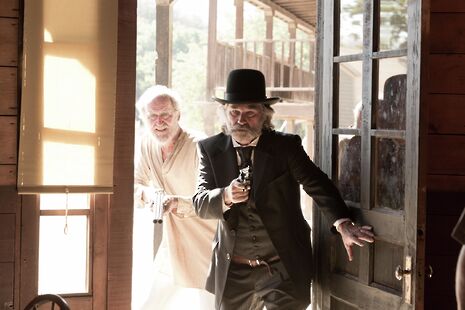Film: Bone Tomahawk
“It is good to have an end to journey toward; but it is the journey that matters, in the end.”

Right from the word go, multi-talented S. Craig Zahler’s latest offering, Bone Tomahawk, is an unforgiving and mesmerising visual assault. Set in the Old West at the turn of the century, the film follows a group of four men whose journey across the American outback to save their fellow settlers becomes an exercise of endurance and comradeship in the face of terrible adversity.
After brutally murdering a small group of travellers, two bandits (Sid Haig and David Arquette), proudly declare their devotion to the ‘civilised’ world of white America (the irony is not lost on the viewer), stumble across an eldritch and skull-adorned burial site. This, it quickly transpires, is ‘troglodyte’ territory – a mysterious, flesh-eating clan of Native Americans who communicate through mutilated throats with blood-curdling screams (this is perhaps the film’s only blind spot: more on that later). Though one of the pair is killed, the other, David Arquette’s witless and immoral Purvis, survives and escapes to Bright Hope, a small nowhere town. Despite town sheriff Franklin Hunt’s (Kurt Russell) best efforts to keep the suspicious interloper locked up over night, Purvis is recaptured by the troglodytes, along with the town’s doctor (Lili Simmons) and the Sheriff’s deputy (Evan Jonigkeit). The resulting rescue mission, orchestrated by Hunt and three of Bright Hope’s best, is perilous, and there is a sticky end in store for more than one of the film’s impressive cast of characters. But, as novelist Ursula K. Le Guin once wrote: “It is good to have an end to journey toward; but it is the journey that matters, in the end.” Certainly this is true of Bone Tomahawk, a film that is Revenant-esque in its gripping portrayal of solitude and struggle, of humankind dwarfed by the beauty and grandeur of a vast American landscape.
Packed with memorable lines (“I know the world’s supposed to be round,” muses Jenkins’s character, Chicory, “but I ain’t so sure about this part”), Bone Tomahawk is a captivating tale of American resilience that pulls you into its world of reckless outlaws and nightmarish cannibals. Kurt Russell gives a commanding performance as the town’s firm yet lovable sheriff. Even Matthew Fox’s performance is funny and charming – a million miles away from his stint as Dr Jack Shephard on the bizarro desert island in Lost that made him a household name.
The film’s major flaw, as hinted at above, lies in Zahler’s monstrous tribe of Native Americans. They are a language-less group of cave dwellers whom Bright Hope’s resident, expert on all things indigenous, takes great pains to distance himself from: “They’re a spoilt bloodline of inbred animals that rape and eat their own mothers.” If, at this point, we are beginning to think that Zahler’s cannibals might be an offensive and savage rendering of America’s native population, we are reassured that though “a man like you [Sheriff Hunt] would not distinguish them from Indians […] they’re something else entirely.” Somehow, this explanation doesn’t quite cut it, and the film suffers from an out-dated brand of primitivism. This being said, it is a film well worth seeing, one that, as the Guardian’s Peter Bradshaw rightly puts it, feels “destined for cult status”.
 Comment / Plastic pubs: the problem with Cambridge alehouses 5 January 2026
Comment / Plastic pubs: the problem with Cambridge alehouses 5 January 2026 News / Cambridge academics stand out in King’s 2026 Honours List2 January 2026
News / Cambridge academics stand out in King’s 2026 Honours List2 January 2026 News / Cambridge businesses concerned infrastructure delays will hurt growth5 January 2026
News / Cambridge businesses concerned infrastructure delays will hurt growth5 January 2026 News / AstraZeneca sues for £32 million over faulty construction at Cambridge Campus31 December 2025
News / AstraZeneca sues for £32 million over faulty construction at Cambridge Campus31 December 2025 Interviews / You don’t need to peak at Cambridge, says Robin Harding31 December 2025
Interviews / You don’t need to peak at Cambridge, says Robin Harding31 December 2025








